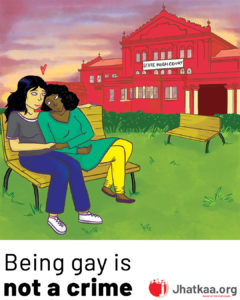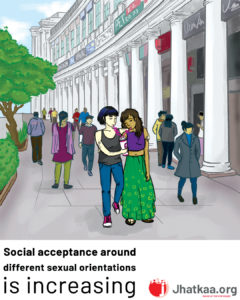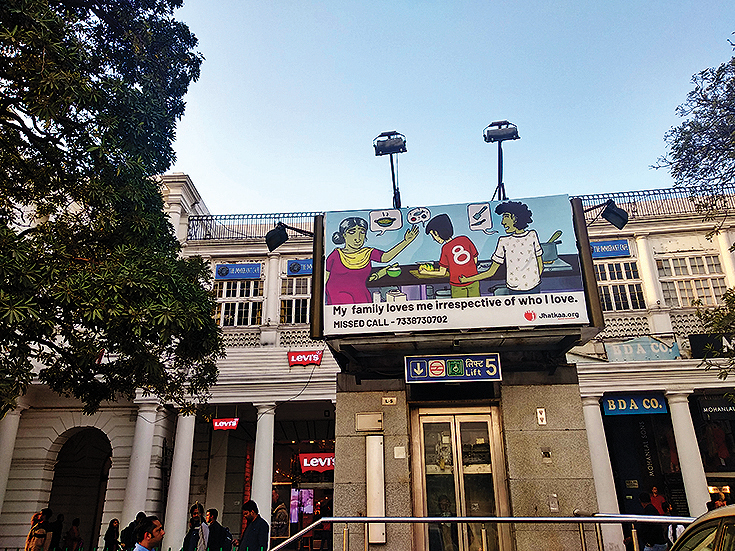The initial illustration for a billboard which aimed to wipe out the stigma around the LGBT community, was not accepted by the authorities. The new one is not very effective
It’s business as usual in the bustling lane of Block B in Connaught Place. But up above something is different — a hoarding that projects the LGBT community in India.
The billboard shows a mother with her son, who has his male partner next to him. The men are cooking together and the lady can be seen raising her hand towards them as a sign of affection and acceptance.
The billboards installed above one of Rajiv Chowk Metro station’s elevator, are part of a campaign to raise awareness about LGBT rights and life in India. Connaught Place was chosen as the first location to put up these billboards because there is a huge crowd there and people can stop and have a look at the billboard.
Four months since the Supreme Court struck down Section 377, which criminalised gay sex, activists at Jhatkaa.org — a campaigning organisation —thought that a dialogue needs to be initiated on LGBT rights in Delhi and across the country.
“The main objective of this campaign is to push the conversation about LGBT rights towards social acceptance and the normalisation of queerness,” says Jyotsna Sara George, campaign manager at Jhatkaa.org.
George says that the preparation for the campaign began in June, way before the verdict came out. The organisation got in touch with an international organisation called All Out. This organisation mainly focuses on political advocacy of LGBT rights.
Since the campaign required funds, Jhatkaa.org, along with All Out, started a crowdfunding campaign and raised a significant amount of money.
According to George, some members hail from countries where same sex marriage is already legal. “They empathised and stood up in solidarity by financially supporting this campaign,” adds George.
“It shows that people care. The contribution from each donor was not much, but the amount we raised shows that there are many people who are supportive of this campaign,” says Punita Maheshwari, a campaigner.
Once the money was raised, Jhatkaa.org started a poll on various social media platforms like Facebook and Instagram. In the poll, four artworks highlight the legal aspect, acceptance from families, place in mythology, cultural traditions and society.

The illustrations were made by Shalaka Pai, an artist who identifies himself as part of the LGBTQ community. “We did this deliberately, so that their experience reflects in their work. Our larger objective is to create more visibility for them,” says George.
The illustrations for the ad went through a two-round polling contest that was conducted on Facebook.
“The winning illustration shows a lesbian couple sitting on a bench in front of the Delhi High Court. Below the illustration, a text in Hindi and English says, ‘Being gay is not a crime/Samalaingik hona kaanooni apradh nahi hain.’
But this illustration was not approved by the Delhi Metro Rail Corporation’s (DMRC) vendor agency.
The ad agency that Jhatkaa.org was working with, sent a message stating the reason for DMRC’s disapproval. The message reads: “DMRC reserves the right of any layout approval. They have been conveyed to modify the said creative without any picture and with an informatory message adaption.”
This is DMRC’s vendor agency indirectly presenting a case of heteronormativity. The original illustration was changed and the illustration that the billboard now carries, buries the message that it was supposed to highlight, in order to be suitable for gaining approval.
George says, “DMRC does not have any liability because all their advertising spaces have been given to different vendors. They don’t directly communicate with anybody.” She also says that there are no exclusive advertising guidelines on sexuality. “But of course, it’s open to interpretation.
We understood that they are trying to exercise some form of censorship, even though they directly did not say so,” she adds.
“They can’t say that directly after the verdict. But this is the sort of mindset of the person in-charge at the vendors agency, who decides what sort of illustration would go up,” says George. However, Jhatkaa.org is not taking this lightly, and Maheshwari says that the organisation is currently working on a petition after getting the facts and figures right. An onlooker in the block was asked to explain what the billboard depicts, she says on conditions of anonymity: “I think it’s a mother and her two sons cooking together and they’re happy. But I don’t know how the message correlates to this.” When she was told that it’s a gay couple with a mother, she was first shocked then happy. She goes on to say, “It doesn’t seem like that. Is it some sort of censorship?”
It feels the message is lost in translation to satisfy the DMRC vendor’s idea of what is right for society. This sort of heteronormativity has been seen in other parts of the world too.

In May, Mango TV, a Chinese broadcast channel blurred the rainbow flag and tattoos on air. In Qatar, some articles on LGBT issues published in The New York Times’ international edition were censored too.
This week too, a few people in Bulgaria destroyed a campaign poster advocating LGBT rights.
A number on which the public can send missed calls — 7338730702 — is also provided on the billboard. The idea behind this is to get a curious person to reach out to the organisation. “If they want to know more, they can give a missed call on this number, and we can add them to our WhatsApp list,” adds George.
This is a pilot project and the organisation may soon take this campaign to Tier-II cities like Jaipur.
“We want to take it to other cities to start a dialogue. We need people to talk about it first. Because it is as natural as anything else. They can judge later whether it’s good or not,” says Maheshwari.
By evening, as CP comes to life with people from all walks of life taking a stroll, the billboard catches the attention of an elderly couple. The couple asks, “Are they partners?” On confirmation, they smile approvingly and continue on their path.





